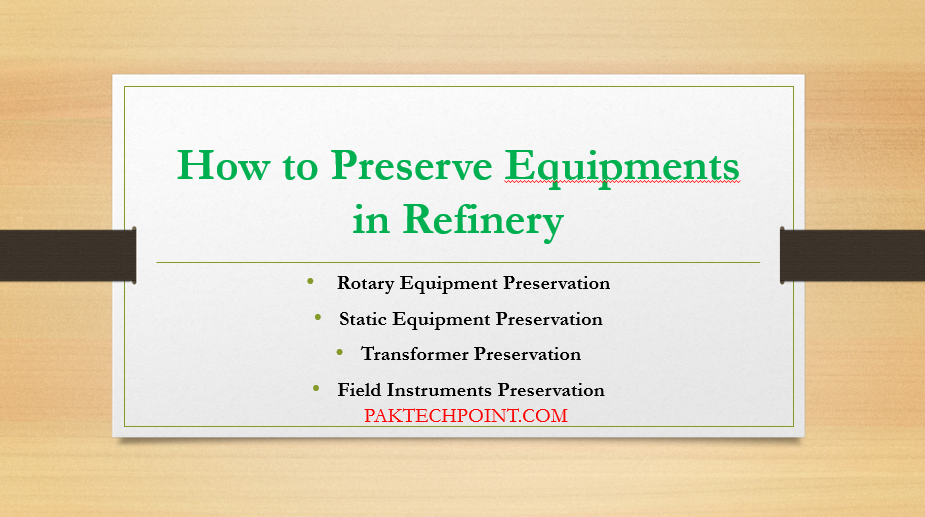Main keywords for this article are How to Preserve Equipments in Refinery, Rotary Equipment Preservation,Static Equipment Preservation,Transformer Preservation, Field Instruments Preservation.
How to Preserve Equipments in Refinery and Plants
This Procedure covers all equipment (static and ratary) received and stored at the project site, temporary lay down and fabrication yards for new project.
This procedure is outlines the requirements for storage and preservation of equipments necessary to prevent deterioration and damage prior to installation and subsequent commissioning and handover of the facilities to commissioning work.
Contractor Responsibilities:
Contractors are responsible for implementing Equipment preservation plan as established in this procedure after equipments coming at construction storage area and/or installation at site. Also organized a preservation team to implement day to day preservation activity.
Wearhouse : From receiving to handover to construction devision/team
Construction Team : After installation at site
DOCUMENTATION:
Contractor will prepare equipment specific inspection Log Sheets. A log sheet is completed for each equipment item or package requiring preservation and used to preservation records as they occur. All the individual preservation activities with each equipment item number, the type of preservation performed, date of each activity was performed recorded.
ROTARY EQUIPMENT PRESERVATION:
The shaft of all mechanical equipment is rotated as specified in the equipment preservation formats, spare rotating elements are stored indoors and as per the manufacturers recommendations. Equipment seal pots, pressurizaition piston assemblies and related instrumentation that are shipped loose are stored indoors. All internal surfaces of bearing housings and gear unit cases are maintaine using the specified preservation. Vent and drain connections are plugged, capped, or blinded, as applicable, using steel fittings. All blind have gasket installed. For rotary equipment line centrefugal fans, pumps, rotary blowers, and other mechanical equipments are protected as follows:
1) Per manufactures recommendations
2) Expert Canned Pump (Non-Seal pump, Submersible motor pump & Cryogenic pump)
3) Fill double and tandem mechanical oil seal with seal oil
4) Plug or cap any opening
5) Spray shaft and hubs with preservation
6) Inspect and coat painted for machined surfaces
7) Protect exposed shafts with cloth wrap as required
8) Protect oil and level gauges as required
9) Fill bearing housing with oil as required
10) Purge for grease bearing
11) Preserve internals of lube and seal oil system
12) Fill gear box with lubricant as required
13) Movable parts of burners are protected with light oil
14) Verify space heaters are operational as required
15) Check Nitrogen Pressure for Spare Rotor Enclosure
STATIC EQUIPMENT PRESERVATION:
Vessel, exchagers, columns, boilers, stacks and others static equipments are protected as follows until start up. Refractory materials are kept dry at all times. Atmospheric moisture is excluded by capping stack and duct openings and sealing locations where water or moist air can enter. Supplimentary heat or a desiccant may also be used.
1) Pressure reading for static equipment
2) Cover all nozzles with a gasket cover
3) Close all opening tightly
4) Check nitrogen purge and as required
5) Hinges on access doors are coated thoroughly with a heavy grease to permit immediate functioning
6) Inspect for presence of moisture
7) Measure insulation resistance as required
8) Check exterior prime coat for damage and touch up where necessary
9) Refractory materials checked whether it is in dry condition or not
TRANSFORMER PRESERVATION:
If a transformer is shipped with its main tank filled with insulating liquid and blanketed with N2 under pressure (or filled with N2 under pressure). measure and record the gas pressure and the ambient temperature when the unit arrives at site.
For electric motor, check whether drain-breather plug is provided on mouted motor.
Measure and record the gas pressure and the ambient temperature and every month thereafter. If the pressure falls, repair leaks it as for transformers and add N2 to keep the pressure within tolerances. It will be protected as follows until start up.
Record the gas pressure and ambient temperature for transformer
CHEMICAL AND CATALYSTS PRESERVATION:
Indoor storage is required for sacked and packaged chemicals and catalysts. Chemical and catalyst are palletized with a minimum of 6 inches or air space between pallets. Drums of chemicals or catalysts are stored outdoors with proper covering by canvas or PE sheet.
FIELD INSTRUMENTS PRESERVATION:
Flowmeters, Control valves, Raidial type levels, Orifice flanges are checked periodically.
1 Flange surface & coat status
2 Painting status
3 Plug or Cap any opening
Equipment Preservation Control Sheet
– Nitrogen Purge and Add
– Rotate Shaft Turns
– Plug and Cap any openings
– Preserve Internals of Lube and Seal Oil System
– Paint Check
– Measure and Record the gas pressure and ambient temperature for Transformers
We have discussed here Main keywords for this article are How to Preserve Equipments in Refinery, Rotary Equipment Preservation,Static Equipment Preservation,Transformer Preservation, Field Instruments Preservation.
